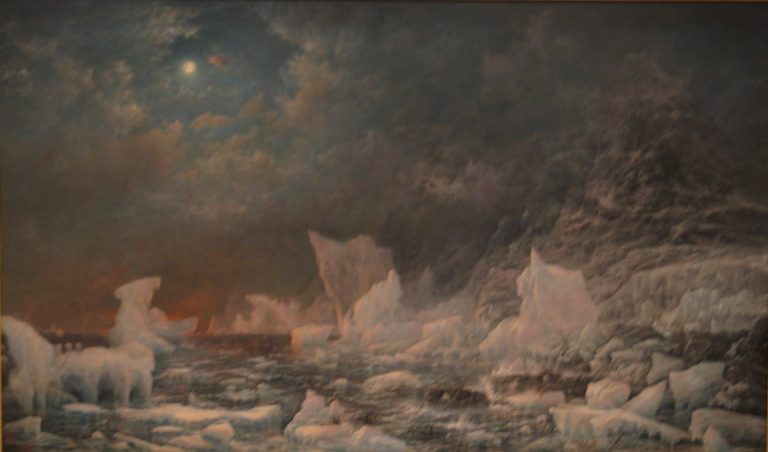We acknowledge the Traditional Owners of the land on which the Queensland Art Gallery | Gallery of Modern Art stands and recognise the creative contribution First Australians make to the art and culture of this country.

Isaac Walter Jenner / England/Australia 1836–1902 / Cape Chudleigh, Coast of Labrador 1893, reworked 1895 / Oil on canvas on composition board / 76.5 x 126.9cm / Gift of the artist 1895 / Collection: Queensland Art Gallery | Gallery of Modern Art
Isaac Walter JennerCape Chudleigh, Coast of Labrador 1893–1895
Not Currently on Display
This image of the coast of Labrador, Canada, recalls some of Isaac Walter Jenner’s own voyages to ‘the frozen North’. However, the distant crimson glow also appears to suggest the fate of a ship which disappeared during a failed expedition to discover the North-West Passage from the Atlantic to the Pacific Ocean. The tragedy captured popular imagination during the nineteenth century.
Isaac Walter Jenner holds an important place in Queensland’s colonial art history. Self-taught, he had some success in England before moving to Brisbane in 1883. Jenner was a founding member of the Queensland Art Society in 1887 and lobbied consistently for the establishment of a national gallery in Queensland.
Jenner taught art at Miss O’Connor’s School, Oxley, and from 1887 had a private teaching studio at the Brisbane Technical College. His studio at Taringa attracted leading Queensland artists and he is known to have encouraged artist JJ Hilder.
When the Queensland National Art Gallery opened in 1895, Jenner was one of the first three artists to present a painting to the gallery: Cape Chudleigh, Coast of Labrador 1893, reworked 1895.
Discussion Questions
1. Look at the artist’s use of colours and shapes within the landscape, and the distance to the horizon. How has the artist used these visual elements to describe the Arctic winter?
2. How do these powerful visuals add to the ‘sense of place’ being conveyed in this scene? How does the fact that Jenner was a new immigrant to Australia influence his interpretation of the romantic scene he created?
Classroom Activities
1. Draw a picture of your classroom from where you are sitting. Change the shapes, colours and lines to make the view to the nearest exit look dangerous. Think about how changing the appearance of usually safe objects, like desks, chairs, the floor, bookshelves or light switches, can achieve this effect.
2. Think of a landscape as a metaphor for a human tragedy. Research the historical, geographic and biological aspects of this place. Then use this information to create a digital collage or a painting or drawing.